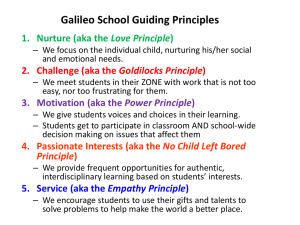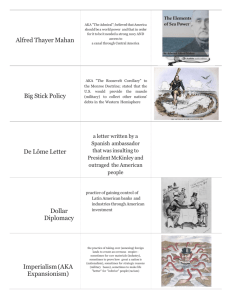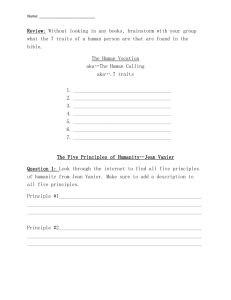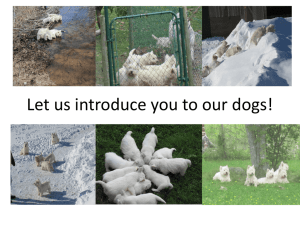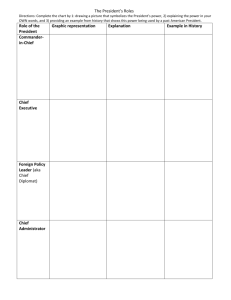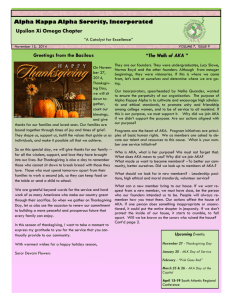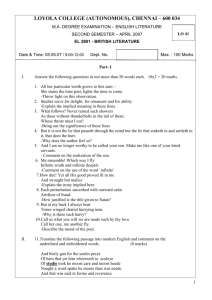The Bare Necessities Guide to… HL IB Business and Management
advertisement
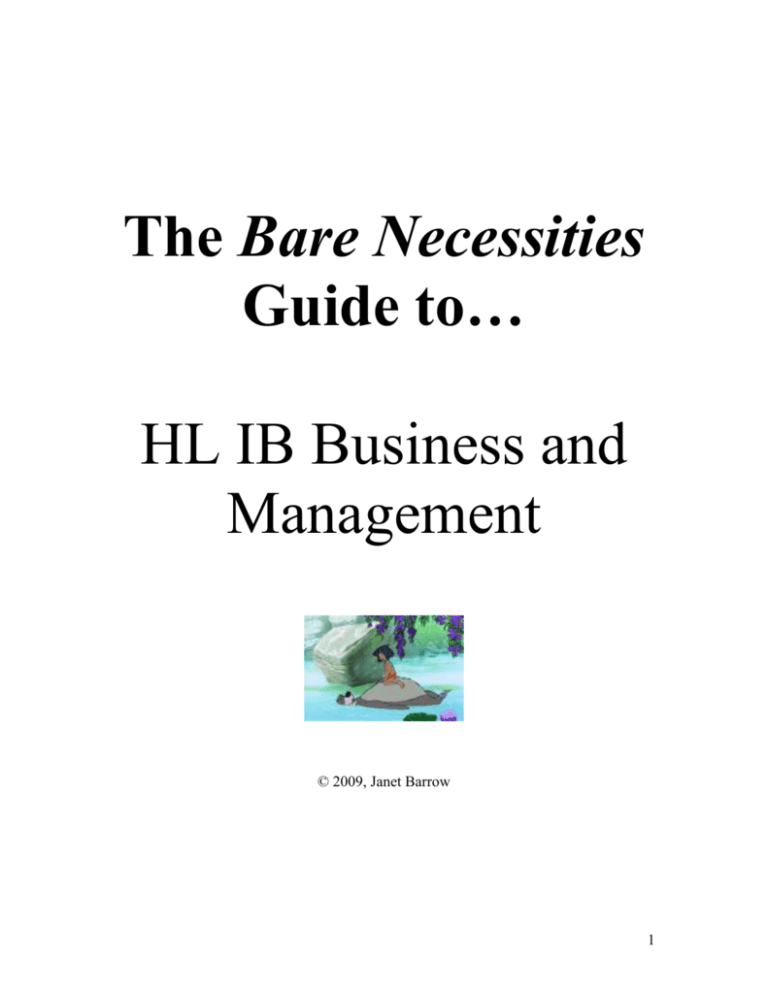
The Bare Necessities Guide to… HL IB Business and Management © 2009, Janet Barrow 1 EVEN IF YOU KNOW SYLLABUS CONTENT 100% YOU MAY NOT SCORE HIGH! The SECRET is to: 1. KNOW HOW TO STRUCTURE YOUR ANSWER TO WIN POINTS FAST IN LIMITED TIME. 2. ACTUALLY ANSWER THE Q ASKED (and not the Q you think was asked). 3. WRITE LEGIBLY 2 THE MAGIC FORMULA State (1 line max). Explain/ justify in relation to story. = 2 points for SL = 1 point for HL _______________________________________________ eg for HL State (4 points) = SSSS Explain (4 points) = SE SE SE SE Analyse (4 points) = + SE -SE + SE -SE Evaluate (4 points) = Analyse + conclusion (- 1 for no conclusion) _______________________________________________ eg for SL State (4 points) = SSSS Explain (4 points) = SE SE Analyse (4 points) = + SE -SE Evaluate (4 points) = Analyse + conclusion (- 1 for no conclusion) 3 !!! SCAN ALL PARTS OF ALL Q’s BEFORE WRITING ANYTHING… THEN… 1. PLAN HOW TO WIN THE POINTS BEFORE YOU ANSWER! THEN CROSS OUT and answer directly underneath. 2. USE SIDE HEADINGS (except for definitions) 3. Write in FULL SENTENCE BULLET POINTS. (Sentences should not start with: To…) 4. SE is 2-3 sentences only. Write more and you will run out of time 5. Watch the TIME. 1m 30 secs per point . Unfinished answers lose almost all points (even if you wrote lots). 6. Avoid broad generalizations eg businesses want to make profit. Some may not eg charities 7. LAYOUT: do not try to save paper Start a new side of the paper for a new part of Q. Start a new page for each new Q. Leave a line between the S or SE points you make 8. DO NOT USE: Good, bad, happy, unhappy, sad … or any ‘emotion’ words. I (unless asked for your personal opinion) don’t, can’t, isn’t, won’t, wouldn’t, get, got To… (at the start of an answer) Slang eg go bust, get sacked. 9. USE ‘WILL’ WITH EXTREME CAUTION: use MAY instead 10. Write big enough to read. Unreadable => NO POINTS! 11. ANSWER WHAT THE Q IS ASKING!!!! • Read the Q at least 3 times and circle key words before planning. • About 50% of responses do not answer the Q asked! 4 EXAMPLE LAYOUT Q1: Evaluate reasons to work at Nestlé (SL 4 points, HL 2 points). • SE $ • SE interest 1. Reasons to work at Nestlé: • People may work to earn money. Nestlé pay them for the work and so they are able to pay for their needs and wants. • The work may be interesting to workers. Nestlé is a diversified company employing many people and so working there may be mentally stimulating. Reasons not to work at Nestlé: • Wages and salaries are low compared to other local employers. This means that employees my have lower disposable income to use for discretionary spending. • It is a big company. This means that people may feel that there is a less personal atmosphere and this may be less motivating for them. Conclusion Employees look for different combinations of monetary and non-monetary reward. The final choice for a particular worker will depend on their personal priorities. 5 CALCULATIONS • DO A WORD EQUATION • PUT THE NUMBERS DIRECTLY UNDER THE WORDS • KEEP = SIGNS IN A STRAIGHT LINE DOWN THE PAGE EXAMPLE: Market share = Number of ice creams sold by Fred x100% Total ice creams sold in the local market = 1,500,000 x 100% 2,000,000 = 75% • BUY A SIMPLE, CHEAP CALCULATOR WITH BIG BUTTONS. • CHECK ALL CALCULATIONS. Most students make calculation errors. • Repetitive calculations should be done on a TABLE. Headings on the table should indicate how the values have been calculated. Eg (a) (b) (a x b) 6 • If calculations you normally put on one table are in different parts of the question DO A NEW TABLE FOR EACH PART OF THE Q. TOPIC 1: BUSINESS ORGANIZATION AND ENVIRONMENT Business Capital + Labour + Enterprise => processes => goods/services Business Functions Production (Operations) Marketing (Product, Price, Promotion, Place) Finance Human Resources (Personnel) Sectors of the Economy Primary = extract/catch/grow raw materials from Earth) Secondary = process raw materials/other secondary goods Tertiary = services eg shops, restaurants If economy grows usually= > Primary down, Secondary and Tertiary up WHY? Producer goods/ services = for other businesses Consumer goods/services = for individual people. WANTS &NEEDS Needs = H2O, food, shelter, warmth Wants = everything else Resources are LIMITED and wants are UNLIMITED Ö scarcity => CHOICE needed Ö OPPORTUNITY COST (next best option) 7 1.2 TYPES OF ORGANIZATION Public sector= owned by government (ESP = for Economic, Social and Political stability of country eg basic services) Often regulates private sector businesses Private = owned by private individuals, often (but not always eg charities) to make profit. May do work for public sector (public sector is biggest spender in an economy) Reasons to set up a business = $, power, fame, interest, boredom doing nothing, desire to help, no job, opportunity presents itself Identifying market opportunity = MARKET NICHE = hole in market Identified by: chance, primary research, secondary research Problems faced by startups lack of $ lack of knowledge or experience, slow buildup of customer base (run out of working capital) product driven idea rather than market driven location factors Processes to start up Tell taxman (for sole traders) Establish legal documents (all except some traders) Do a Business Plan (see later) PPPP Do budgets and cash flow forecasts Find finance Find location Find suppliers 8 Different Types of Businesses 1. Sole trader = 1 person (+ employees?) - Unincorporated + Keeps all profit - Unlimited liability + Own boss - Long working hours + Easy to set up (just start) - Lack of expertise? - Lack of finance? 2. Partnership (2-20 people: depends on country) Deed Of Partnership => who does what, how profits split Split profits equally unless Deed of Partnership says not - Unincorporated + More capital - Unlimited liability + More knowledge/expertise - Often disagree + work shared Special partnerships eg farmers, Coop shops: a) Buyers Cooperative (buy supplies in bulk at lower price) b) Sellers Cooperative (sell goods in bulk to bigger buyers) 3. Private Limited Companies ! Do not confuse with private companies (private sector) Owned by shareholders (may be family or friends) Shares sold privately + Limited liability - small cost to legally register + Incorporated - shares & control can be sold + quick to set up - ownership diluted - profits have to be split/share + More shareholders => more $ capital put in + Can keep P&L and B/Sheet private 4. Public Limited Companies ! Do not confuse with public sector (government owned) = Shares sold on stock exchange to general public + Incorporated - have to give P&L and B/S free to + Limited liability anyone who asks + access to huge $ - Need to be big with good track + Financial economies record to ‘go public’ of scale (bank loans - Takeover more possible may be cheaper) - Slow and expensive to do 9 5. Franchises (included in 1.7 Growth) HL only = the right to sell another business’s goods eg McDonalds, Sock Shop, (many). Franchisor = bus. that owns the franchise (big guy) Franchisee = bus. that buys the franchise (little guy) The deal from the point of view of the franchisee: + idea proven successful - franchisee pays fees + established name/brand - franchisee takes $ risk + training given - cannot buy supplies cheap + Franchisor does advertising - freedom is limited The deal from the point of view of the franchisor: + no $ needed to expand - may damage brand name + little risk - little control over franchisee + increased market share + up front fee + steady income Non Profit-Organizations aka Not-for-profit organizations eg Charities, pressure groups Many are Non-Governmental Organizations(NGO’s) = registered business with no governmental representation Public/Private Enterprise (HL only) eg Gov educates => workers for business Businesses pay taxes => Gov => Ö economic/social/transport infrastrucure Ö Helps businesses 10 1.3 ORGANIZATIONAL OBJECTIVES = words that seem designed to confuse. Learn in right order! VISION STATEMENT = ideal hopes for distant future MISSION STATEMENT = declares underlying purpose => AIMS = Broad, general LONG TERM (LT) goals => STRATEGY = plan of how to achieve LT AIMS => STRATEGIC OBJECTIVES* aka CORPORATE STRATEGIES = LT (1+ year) objectives => TACTICAL/OPERATIONAL OBJECTIVES* = ST (under a year) objectives => OPERATIONAL STRATEGIES= day to day objectives * OBJECTIVES = SMART (Specific Measurable Achievable Realistic Time-specific) ETHICAL OBJECTIVES = moral values set to protect the world’s scarce resources or people. Ö Analyse + and – of setting them Ö Discuss impact of implementing them CORPORATE SOCIAL RESPONSIBILITY (CSR) = Consideration of ETHICAL and ENVIRONMENTAL issues before making decisions impacting stakeholders Ö Ö Ö Ö Different ethics in different countries Different ethics of same B in diff. countries Changes over time Analyse value of social/environmental audits (independent checks on what they are doing) Ö Why B’s choose diff. CSR strategies 11 1.4 STAKEHOLDERS = any person or B with any interest in this B Internal = employees, shareholders, managers External = suppliers, customers, SIG’s (special interest groups) Competitors Ö Discuss areas of conflict between stakeholders Ö HL: Evaluate ways of overcoming conflict (see conflict later) 1.5 EXTERNAL ENVIRONMENT ANALYSIS: PEST = Political Economic Social Technological PESTLE = PEST + Law + Environment STEEPLE = PESTLE (diff. order!) Ö Evaluate impact on objectives of a change in a PEST factor Ö Analyse/explain impact of external opportunities/threats SWOT ANALYSIS: Strengths Weaknesses = INTERNAL Opportunities Threats = EXTERNAL 1.6 ORGANIZATIONAL PLANNING TOOLS BUSINESS PLANS * Background/ History of B * Ownership * Management (+ CV’s of main people) * Marketing: PPPP, Market outlook, major competitors, suppliers, R&D *Vision Statement, Mission St., Aims, Objectives… * Financial Plans: B/S, P&L, Cash flow forecast, financing, project projections etc. Ö Analyse importance to stakeholders Ö HL: Interpret the implications of the plan 12 DECISION MAKING MODELS (HL ONLY) 1. FISHBONE Identify CAUSES not symptoms!!!! Mangement Manpower ______I___________I_________________Problem I I Machines Materials Evaluate the method: + Easy to use + Logical + Facilitates understanding + Visual + Computerised version available - may be too simplistic so used with other methids 2. SCIENTIFIC VS: INTUITIVE (gut feel) S is objective whereas I is subjective S cannot take into account illogical experience whereas I may have problems evaluating lots of numerical data. 3. DECISION TREES => Construct and Interpret => Critically evaluate BOX= decision point O = chance node => show different possible outcomes Sum of option P’s Expected $ Income (E) E x Probability (P) 13 4. ANSOFF’s MATRIX (HL ONLY) => apply as a decision-making tool Source: tutor2u.net/business/strategy/ansoff_matrix.htm 1.7 GROWTH AND EVOLUTION ECONOMIES OF SCALE !!! ALWAYS comes up. KNOW IT!!! 6 INTERNAL Economies of Scale Purchasing (bulk purchase discounts) Marketing (advertising less per unit) Managerial (one manager, many employees) Financial (loan int. rate may be lower) Technical (big machines cut unit costs) Risk-bearing (range of products into diff. markets) 4 EXTERNAL Economies of Scale (when big B’s locate close to each other) Suppliers locate near customers => transport cost down Local skilled workforce shared => training costs down Support from local council/gov => eg roads built Area gains good reputation for X => eg Swiss watches 14 3 Diseconomies of Scale The bigger the B: Ö harder to manage Ö demotivation Ö decisions take longer SMALL VS LARGE B’s Why grow? 1. Economies of scale 2. Diversification: not all eggs in same basket 3. Financial: big B’s less likely to go bankrupt 4. Personal vanity/desire for power 5. Domination of the market INTERNAL GROWTH (aka Organic Growth) 1. Sell more of current products 2. Sell current product to new markets 3. Develop new product (diversification) or extend line + already good at what do + inexpensive - may take long time to grow EXTERNAL GROWTH (aka Integration) 1. Merger (join), Takeover (one B buys another) + instant growth - less than 50% successful + synergy - conflict of corporate culture + extend geographic - diseconomies of scale + product diversification - management styles differ + complementary products - redundancies => tension + extend expertise => demotivation + economies of scale + instant local experts 15 Types of takeovers/mergers: Horizontal: 2 competitors join Forward vertical: B takes over a customer Backward vertical: B takes over a supplier Lateral/conglomeration: B takes over other B’s with nothing in common => diversification 2. Joint ventures 2 B’s set up a new, jointly-owned B => split risk, costs & control of a big project. Eg Ericsson (Sweden) + Sony (Japan) => Sony Ericsson 3. Strategic Alliances = same as joint ventures except no new B is established and 2 B’s retain own identity. 4. Franchises (see under types of businesses) HL ONLY 1. 8 CHANGE MANAGEMENT (HL ONLY) Causes of change: Customers Competitors Management Technological progress Government Fashion Economy Resistance due to: Self-interest Misunderstandings Poor communication Low tolerance to changes Different viewpoints Lewin’s Force Field Analysis: Driving forces => <= restraining forces 16 STRATEGIES TO REDUCE IMPACT OF CHANGE !!! ALMOST ALWAYS COMES UP!!! * For max points first recognize existence of conflict 1. Education/training 2. Communication 3. Involve all in decision process 4. Support staff 5. Negotiate/agree 6. Manipulation 7. Threaten 1.9 GLOBALIZATION = growing integration and inter-dependence of the world’s economies, ideally with free trade of goods and service Ö towards single world economy with similar habits and tastes Reasons: 1. Deregulation of trade 2. Removal of trade barriers 3. Technological progress eg communication 4. Increasingly similar world tastes 5. Increasing use of English International B’s = based in country A => export Multinational companies (MNE’s) = in several countries Role of Multi-nationals in globalization * Technology transfer * World networks of super-B’s * Culture transfer Problems created by globalization: * Increased competition => price wars => bankruptices * Small B’s find it hard to compete => unemployment * LDC’s cannot compete with efficiencies of big B * Rich countries cannot sell labour => unemployment * Mass traffic of goods across the world => use oil 17 REGIONAL TRADING BLOCS (RTB’s) Aim: free trade of goods, services, labour, capital Often: have barriers to imports from outside the bloc Different RTB’s manage this to varying extents EU = European Union EEA European Economic Area = EU + EFTA (Iceland, Norway, Lichtenstein, Switzerland) NAFTA = North American Free Trade Association ASEAN = Association of SE Asian Nations 18 TOPIC 2: HUMAN RESOURCES 2.1 HR PLANNING Demographic changes: * Birth rate * Migration rate * Retirement age * Unemployment * Mobility of workers => discuss significance * Flexibility of workers * Education level of workers * Women working/ returning to work * Ageing population Changing employment patterns & consequences for employers and employees (HL ONLY) 1. Homeworking: no office needed 2. Teleworking: online or on phone (far country?) 3. Flexitime: fixed hours per month- flexible when do them Handy’s Shamrock Organization (2003) = management theory of ideal, flexible B structure 1/3 core staff 1/3 part-timers 1/3 professional contractors HR ROLES Workforce planning (anticipating demand for workers) based on: • Historical trends • Technology/ capital intensity • Work study • Fashion trends in demand • Natural wastage (people leaving of own accord) • Staff turnover = people leaving/total workforce x 100% • Need for certain skills 19 THE HR CYCLE: Workforce Planning => Work Study => Job Analysis => Job Description (duties, hours, pay) => Person Specification (qualifications and attributes) => Recruitment => Shortlist=> Interview => Selection => Job Offer => Job Contract (within 3 months) => Induction => Appraisal => Training ( internal/external, on-the-job, off-the-job) => Pay/performance analysis => $/non-$ benefits => Union relations/negotiations (collective bargaining) => Dismissal (something illegal or 3 written warnings) /redundancy/layoff/retrenchment (job no longer exists) 2.2 ORGANIZATIONAL STRUCTURE Delegation = passing on AUTHORITY (power) and RESPONSIBILITY (accountability: who’s to blame) Chain of command=line of authority/who reports to whom Levels of Hierarchy = people on same reporting level in B Span of Control = How many people report to someone EFFECT OF FLAT ORGANIZATIONAL STRUCTURE (Centralised) = 1 person has authority & responsibility + Fast decisions + better control/direction - Overwork of main person - Delays due to long queue - Few new ideas - Bureaucracy EFFECT OF TALL ORGANIZATIONAL STRUCTURE (De-centralised) = many levels of hierarchy + Motivation up + Promotion possibilities - Loss of control + Worker input more likely - More mistakes + Faster decisions - Needs good communication 20 MATRIX STRUCTURE (HL ONLY) = flexible structure Employees divided into different teams for different aspects of their job as well as being in a department Ö report to several team leaders + department manager + Variety of people to work with + Best people used on project team + Varied work, more interesting + Experience up + May be more motivating + Projects spread between teams, avoiding overload - Conflict of demands from different leaders - Authority weaker => hard to control - Not found to work well (but was once popular) Mintzberg: B can only be successful if has a flexible structure able to adapt to rapid change Peters: ‘In Search of Excellence’, 1992 1. Flatter structures adapt faster to change. 2. Matrix teams allow more adaptability 3. Less bureaucracy allows faster change Role & importance of Informal Organization = social ‘top dog’s and social ‘pecking order’ Sometimes the informal organization and views conflict with the formal WAYS OF DIVIDING THE HIERARCHY 1. Geography 2. Role/ function eg HR, Marketing, Finance, Production Ö analyse + and – for a B 21 OUTSOURCING (HL ONLY) = using another B for a job/function + Can help in times of overload - Quality? + May be cheaper - Control lost - Fear of redundancies? OFFSHORING (HL ONLY) Transferring work to countries where costs are less Eg Call Centres in India + Cheaper - Redundancies at home - Accents not understood - Customer disapproval MIGRATION OF HR FUNCTIONS = outsourcing/offshoring eg payroll function, recruitment 2.3 COMMUNICATION Effective communication = 2-way with feedback that understood Media of communication: oral, written, visual, formal, informal Barriers to communication !!! Frequent Q Language Distance Technical difficulties Time differences Long chain of command Wide span of control 22 EXAMPLE REPORT FORMAT From: To: Date: J Barrow Mr. P. Groves, Managing Director, Choco Ltd 23rd January, 2008 SUBJECT: Whatever it is about Problem Suggestion Advantages Disadvantages Recommendation ICT Telephone, Skype, Twitters, web sites, email, document sharing, teleconferencing, blogs etc etc Ö discuss the effect of new ICT on effectiveness of communication: + and – COMMUNICATION NETWORKS 1. Wheel 2. Connected network 2.4 LEADERSHIP AND MANAGEMENT LEADERSHIP STYLES 1. Autocratic/dictatorial = 1 person decides. + Fast decisions - LT demotivating + Effective in crisis 2. Democratic = All discuss. All decide. + Many ideas - Slow - ineffective in crisis 3. Laissez Faire = manager lets workers do as they like + lacks bureaucracy - lacks control - LT demotivating 4. Situation Leadership = takes over in a particular situation (may not be formal leader) 23 TRAIT AND SITUATION THEORY (HL ONLY) Are leaders BORN or LEARNT? => many theories (most believe it can be learnt) Listening Enthusiastic Ambitious Decisive Enterprising Recognised Sees big picture High standards Influential Prudent LEADERSHIP THEORISTS (HL ONLY): LIKERT 4 types of management and leadership: 1. Exploitative autocratic: (orders from top with threats) 2. Benevolent autocratic/paternalistic: consider needs and make what they think is best decision for all. 3. Participative: find out views then decide for all. 4. Democratic: find out views and all decide. FIEDLER’s CONTINGENCY THEORY Is not best way of leading: depends on personality and situation BLAKE and MOUTON’ MANGERIAL GRID Source: http://www.mindtools.com/pages/article/newLDR_73.htm 24 TANNEMBAUM AND SCHMIDT: Leadership continuum Tells________________________________________Asks Authoritarian Sells Consults Freedom for subordinates THEORIES OF FUNCTIONS OF MANAGEMENT (HL ONLY) FAYOL (POCCC) 1. Plan 2. Organize 3. Command 4. Coordinate 5. Control HANDY * Managers have: Intelligence + Initiative + Self-assurance * Management key roles are more important: 1. They are like GP’s 2. Confront problems 3. Balance cultural mixes DRUCKER * People are the key to success * Effective communication can avoid ‘them-and-us’ culture Managers: 1. Set objectives(be involved in Strategic Planning/Change => Management by Objectives (SMART) aka MBO BUT should avoid needless change 2. Organize 3. Motivate 4. Measure performance 5. Develop people 25 2.5 MOTIVATION THEORIES 1. TAYLOR’s Theory of Scientific Management Studied factories in early 1900’s Believed workers basically lazy, motivated by $ Did time and motion studies => studied individual tasks Ö Found most efficient way to do task Ö Said managers should be appointed to be sure task was done exactly as planned BUT: Workers bored => productivity down 2. MASLOW’s Hierarchy of Needs Self Actualisation Self-esteem Love & belonging Safety Physical survival(needs) 3. McGREGOR’s Theory X and Theory Y Theory X: workers lazy, dislike work, lack ambition, motivated by $, need to be controlled/coerced by managers. Theory Y: Workers can take pride in and responsibility for their jobs. Managers should encourage them. 4. HERZBERG’s Hygiene factors * Hygiene factors = things that B has to provide or workers will be dissatisfied. = potential demotivators * Motivating factors = things which will encourage workers eg praise, advancement. 5. MAYO’s Human Relations School (HL ONLY) Hawthorn Effect = non-financial factors more important 1. Taking a personal interest eg involve in decisions 2. Meeting personal needs 3. Social contact 6. McCLELLAND’s Theory of Needs (HL ONLY) People with different needs have different motivators eg Need for Achievement Need for Power Need for Affiliation 26 7. VROOM’s Expectancy Theory (HL ONLY) People have diff. expectations People expect reward for meeting expectations 8. ADAM’s Equity Theory (HL ONLY) People compare themselves to other workers Reward should reflect effort and results Degree of EQUITY (fairness) affects motivation Inequality => absenteeism => costs up People place diff. values on diff. rewards… so is hard to get it right! MOTIVATING FACTORS Financial: pay, bonuses, piece work, pension plan, commission, profitrelated pay, performance-related pay, perks (fringe benefits) eg pension, accommodation, health plan Non-Financial: Job enrichment => better things to do Job rotation => swap jobs Job enlargement => more to do Kaizen (teams have resp. for improvement) Flexible working practices Training Praise Empowerment (give authority) Cell production Quality circles Work facilities 2.6 CORPORATE CULTURES (aka Organizational cultures (HL ONLY) = Norms in a B eg dress, attitudes Ö Analyse effect on a) motivation b) structures Ö Analyse conflicts of: a) mergers b) change of leadership style 27 2.7 EMPLOYER & EMPLOYEE RELATIONS (HL ONLY) Trade Unions => Collective bargaining => so the person who complains does not get sacked! Sources of conflict: pay, conditions, hours, redundancies, unfair dismissal, outsourcing, offshoring, Industrial action by unions: all out strike, work-to-rule, go slow, overtime ban, selective strike… Management tools: negotiation, PR, threats of redundancies, change of contract (not possible in all countries), closure, lockouts Conflict resolution possibilities: 1. Negotiation 2. Conciliation aka Mediation: independent arbitrator helps negotiation 3. Arbitration: independent arbitrator listens to both sides than makes a legally-binding decision. Other concepts: Closed Shop aka Single Union Agreement = all workers have to be a member of the same union (avoids negotiation with several unions). No Strike Agreement eg firemen 2.8 CRISIS MANAGEMENT (CM) & CONTINGENCY PLANNING (CP) (HL ONLY) CM (if it happens) Eg disaster recovery + continuity plans CP (reduce risk of crisis: impossible to avoid ALL risks) + reduce risks - $ & time + reduce impact of crisis - May never happen + reassures staff - Cannot think of all disasters 28 TOPIC 3: ACCOUNTS AND FINANCE 3.1 SOURCES OF FINANCE Always match the period of the need with the time period to repay!!! INTERNAL FINANCE • Retained profits • Credit control = make customers (debtors) pay sooner • Sell some fixed assets (but may need them!) • Run down stocks so have less $ tied up in them • Use saved-up $ EXTERNAL FINANCE Short Term (ST) = less than a year • Personal savings (not for Ltd or PLC) • Friends or family (not for Ltd or PLC) • Overdraft (= draw out more money from bank account than have in there = flexible but expensive) • ST Loan (fixed amount but cheaper than OD) • Make creditors wait for their money • Sell receivables (debtors) to Debt Factoring Company (at big discount!) Medium Term (MT) = 1-5 years • Bank loan (lose collateral if do not pay?) • Leasing (pay monthly but never yours) • Hire Purchase (pay monthly, eventually yours, very expensive) • EEC loans, Government loans, Local Gov. loans, grants Long Term (5+ years) • Mortgage (property as collateral) • Issue more shares (BUT: Interest is effectively paid after tax in the form of dividends = hidden extra expense) • Debentures = LT IOU’s => sold on market. Interest rate fixed up front. Up to 25 years. BIG PLC’s and countries only 29 FACTORS AFFECTING CHOICE 1. $ Amount 2. Time needed: ALWYS MATCH TIME! 3. Cost of finance (Note: dividends paid after tax so is hidden cost) 4. Size and type of B 3.2 INVESTMENT APPRAISAL $’000 Year Cash flow Cumulative CF (c) 0 (100) (100) 1 50 (50) 2 60 10 3 40 50 50 5% Discount* (d) 1 0.9524 0.9070 0.8638 NPV (c x d) (100) 47.62 58.20 34.55 40.37 * From discount tables ARR = Average Rate of Return = Net Cash Flow /years x 100% Initial investment = 50/3 x 100% 100 = 16.7% Payback Period = The year number it is last a negative figure on the Cumulative balance column… plus some months which you work out like this: The negative number from above Positive Cash flow the next year = 1 year and (50) / 60 = 1 year 10 months x 12 months x 12 months 30 3.3 WORKING CAPITAL Working Capital Cycle: When a B makes things it pays out for things eg raw materials, labour, energy, rent, wages, salaries etc. It has to finance all this money until it gets paid. $$$$$$ tied up in all this is WORKING CAPITAL. This is eventually followed by $ IN when the customer pays … then it starts again = working capital cycle On the B/Sheet: Working Capital = CA-CL 31 CASH FLOW FORECASTS !!! The secret is in the LAYOUT!!! $’000 Sales $ IN Cash sales 50% Debtors (1mth) Total IN (I) JAN 20 FEB 10 MAR 80 <= Write in sales to help calcs !!!!!! 10 15* 25 5 10 15 40 5 45 (15) (10) (5) Rent (10) Salaries (10) Total OUT (O) (35) (10) (10) (30) (10) (10) (25) Net Cash Flow (10) (I-O) BANK: Opening 60* Balance (B) (15) 20 50 35 35 55 $ OUT Creditors (1 month credit) Closing Balance (I-O) + B 50 * Given in text… so read it VERY carefully to find the numbers you do not know! 32 3.4 BUDGETING Budget = SMART Specific, Measurable, Agreed, Realistic, Time Specific Sales PLAN (P) 10 ACTUAL (A) 15 VARIANCE (P-A) 5 Good/bad? Costs 5 10 5 Bad Profit 5 5 0 - Good ROLE OF BUDGETING: Planning and guidance Coordination Control Motivation Pre-arrange finance Bank manager will use info to monitor loan Warns if something going wrong (so can adapt plans) PROBLEMS Numbers are only guesses Tend to be over-optimistic If under-spend cannot carry $ to next year (so may as well spend it!) 33 3.5 FINAL ACCOUNTS Profit and Loss Statement Sales (Direct costs) = Mostly Variable Costs Gross Profit = Contribution towards fixed costs (used in marginal costing) !!! Up to here is called the Trading Account (Expenses)* aka OVERHEADS. Mostly Fixed Costs Net Profit Before Interest and Tax (Interest) (Tax) Net Profit After Interest and Tax Ö some paid out to S/H as DIVIDENDS (per share) Ö rest is put into balance sheet as RETAINED EARNINGS *NOTE ON EXPENSES = mostly OVERHEADS, mostly FIXED COSTS BUT may also include: • This year’s DEPRECIATION cost • GOODWILL costs (= when buy a B you pay more than the asset cost. The extra bit is Goodwill: not allowed to keep it on balance sheet… so have to write it off as a cost) APPROPRIATION ACCOUNT = the last bit of the P&L = shows how profits are used => tax, dividends, rest to Ret.Earnings 34 BALANCE SHEET Traditional Layout: ASSETS (own) Current Assets (0-1 year) Cash Stock Debtors (receivables) LIABILITIES (owe) Current Liabilities Overdrafts ST Loans Creditors (payables) Medium Term Assets (1-5 yrs) Equipment MT Liabilities MT Loans Fixed Assets (5+yrs) Big Machinery Land Buildings Goodwill (not allowed to stay!) LT Liabilities LT Loan Mortgages Debentures Shareholders’ Funds Share Captital Retained Earnings (aka Reserves) ____________________ ________________________ TOTAL ASSETS = TOTAL LIABILITIES ____________________________________________________________ Alternative Layout (IB way) Fixed Assets (FA) Current Assets (Current Liabilities) Working Capital (WC) Net Assets (FA + WC) (balances with Capital Employed) MTL LTL SH Funds Capital Employed (balances with Net Assets!!!) 35 DEPRECIATION Fixed Assets (FA’s) have to be depreciated over their lifetime or according to accounting and tax rules. Ö $ hits cash flow immediately FA is paid for Ö Then a bit of the cost goes on P&L as an EXPENSE each year over the lifetime = DEPRECIATION Ö The depreciation is shown as a negative against the asset value on the B/S. Ö SO the cost of the FA has to be divided up; there are 2 ways of calculating it: 1. STRAIGHT LINE DEPRECIATION = same amount each year = cost – residual or scrap value No. of years + Easy to calculate + spreads cost equally - unrealistic 2. DIMINISHING BALANCE DEPRECATION (more realistic) (Cost – residual or scrap value) x same % each year eg if cost is $100 and residual value is $20 and annual depreciation is 20%: Year 1 2 3 Start Value $ 80 64 51.20 Depn.$ 16 12.8 10.24 etc End value$ 64 51.2 GOODWILL/BRANDS/PATENTS/COPYRIGHTS Goodwill = amount paid for a B above the net asset value All have to be written off asap. Are written off like depreciation 36 STOCK VALUATION The PRICE of buying stock often changes. So how is the stock left at the end of the year valued? Buy 10@ $2 => Buy 15 @ $3 => Sell 20 $Value 20 45 ?????????? There are 3 ways of working out the $value … but you only need to know 2: 1. Last In First Out (LIFO) Buy 10@ $2 Buy 15 @ $3 $Value 20 45 Sell 5 15 $Sold 10 45 55 $Left 10 0 10 Sell 10 10 $Sold 20 30 50 $Left 0 15 15 2. First In First Out (FIFO) Buy 10@ $2 Buy 15 @ $3 $Value 20 45 LIFO => Costs higher FIFO => Costs lower => Profit less => Profit higher Remaining Stock value less Remaining stock value more 37 3.6 RATIO ANALYSIS !!! HL students should try to avoid choosing ratio analysis Q’s. Marks are often low as this is a complex skill which takes a long time to master. REMEMBER: P&L and B/S figures only tell you what happened in the PAST… they are not a crystal ball to tell you about the future 1. Profitability Ratios (GP Margin, NP Margin) General formula = Profit x 100% Sales This is the proportion of sales kept as profit. ___________________________________________________________ 2. Liquidity Ratios Current ratio = CA !!!Working Capital = CA - CL CL = number of times CL’s can be repaid by turning CA’s into cash (liquid form). Acid Test Ratio = CA – Stock CL = number of times CL’s can be repaid by turning CA’s into cash, but counting stock as worth nothing. Ö This is because if B tries to sell stock in a big hurry they probably will not get anything for it. _____________________________________________________________ 3. Efficiency Ratios (! Only Stock turnover is SL) These find after how many days the B: * Uses up all its stock (faster is more efficient) * On average repays its creditors (Is good to be slow because it means they are financing it. BUT if B takes too long to pay their suppliers put up prices) Is repaid by its customers ( faster is better but if B pushes them to pay too fast they may buy from another B). 38 Return on Capital Employed (ROCE) This shows the profit of a business in relation to the $ which has been invested LT in the B by its shareholders and other LT lenders. = NPBIT x 100% Capital employed* * CE = shareholders’ funds + LTL 5.Shareholder Ratios (HL ONLY) Earnings per share = NPAIT No. of Shares This enables investors to work out what income to expect from their shares. Dividend Yield = 6. Gearing Ratio = Dividend per share 100% Market price of shares This enables investors to compare the return on what they pay for shares compared to alternative investments eg bank deposits. LTL LTL + Shareholders funds This shows what fraction of LT investment in the B is from LT lenders (= usually the banks). LT lenders do not want to invest more in the B than the shareholders are prepared to invest. They may ask the B to sell more shares rather than take another loan if the gearing is too high. 39 TOPIC 4: MARKETING Product Price Promotion Place (!!! Distribution Method) !!! Q’s usually expect answers based on 1st four only People Process Physical evidence (what it looks like) Packaging Marketing Mix = Product, Price, Promotion, Place etc Product Mix = range of products sold by B 4.1 THE ROLE OF MARKETING is to: 1. Increase Market Share = $Sales by B x 100% Total $sales in market 2. Increase market size 3. Increase profit MARKET DRIVEN MARKETING (most successful strategy) = Do research to find market niche => Then develop a product to fill wants and needs of market May target selling to particular market segments to reduce promotion costs. PRODUCT DRIVEN MARKETING= invent a product then try to sell it SOCIAL MARKETING (HL ONLY) = programs aiming at social change eg Governments and charities eg smoking kills campaigns ASSET LED MARKETING (HL ONLY) = Marketing restricted to core strengths of B 40 4.2 MARKETING PLAN • • • • • • • • • Marketing audit = where are we now? Competitor study Primary research Marketing budget PPPP strategy (must be SMART) Marketing Mix & Product Mix Ethics in methods and countries PEST analysis = Political, Economic, Social, Technical SWOT analysis = (Internal Strengths & Weaknesses) + External Opportunities & Threats) PORTER’s 5 FORCES (HL ONLY) = Competitive rivalry, Suppliers, Buyers, New entrants, Substitutes PRIMARY RESEARCH (aka Field Research) Eg questionnaires, interviews, discussion groups, customer panels + Tailored to specific Q’s + Up-to-date - Slow and costly Sampling for Primary Research (HL ONLY): random quota = based on market segmentation (some from every segment) stratified = sample composition reflects % in each segment cluster = one place, one time to save time & $ snowballing = each interviewee suggests someone else SECONDARY RESEARCH (aka Desk Research) = finding out other people’s research eg web, articles, trade journals, government reports, newspapers etc. + Instant + Cheap - Q’s my not suit this B… may be biased - Old? 41 4.3 PRODUCT PRODUCT DEVELOPMENT PROCESS Market research => identify market niche => R&D=> prototype => testing => test marketing => final product => identify distribution network => sell => market research =>feedback => update etc. PRODUCT LIFE CYCLE Maturity Saturation => extension strategies eg Special offers, updated product, change packaging, advertising. Sales Growth Decline Launch Obsolescence _________________________________________________________Time PRICING STRATEGY ACCORDING TO PLACE IN CYCLE: Launch: competition, skimming, penetration, cost+, % profit Growth, Maturity: competition Saturation: special offers, new product pricing Obsolescence: low price to sell off PROMOTION: Amount and type changes with cycle BOSTON MATRIX aka BCG Matrix Market Growth High Market Share High Low Star Problem Child Low Cash Cow Dog Cash cows give $ to support problem children. Dogs are in decline and will eventually be allowed to die (=> dead dogs!) 42 B’s usually have products at all parts of this cycle to ensure they have a steady stream of new products for the future. BRANDING (!!! Often comes up in exam) + Logo => customers identify it easily + Risk reducer => brand loyalty + Image enhancer => premium price + Sales generator => can reduce price elasticity of demand + Some products stay indefinitely at maturity eg Coke + Puts high barriers to entry for competitors Types of Branding (HL ONLY) Family Branding = several products. 1 brand eg Sony Company/Manufacturer’s Brand = B name used as brand eg Heinz Product Branding eg Toyota use Lexus for luxury end Own Label Brand eg supermarket brands 4.4 PRICE * Price Skimming = price high to start => cover costs early * Penetration Pricing = low price to establish market position * Competition Pricing = Going rate * Cost Plus eg cost +10% HL ONLY: * Predator/Destroyer pricing = V. low price to destroy competition… then put price up high (only possible if have dominant market position and can fund temporary losses) * Price discrimination eg kids free *Loss leader = one cheap item acts as bait to attract customers * Psychological Pricing eg $99.99 * Promotional Pricing eg special offer for short time SUPPLY AND DEMAND Supply UP or Demand DOWN => PRICE down 43 ELASTICITY (HL ONLY) Price Elasticity of Demand (PED) = % change in Quantity % change in Price above 1 = elastic = when price changes quantity demanded changes more eg if put price up 10%, quantity sold goes down more than 10%. Cross price elasticity = % change in Q product B sold % change in Price of product A Is used when products are SUBSTITUES eg butter/marge Or when products are LINKED eg X-box and X-box games !!! Putting the price up does not always mean more profit 4.5 PROMOTION (!!! Not just advertising!!!) = Advertising (different media for different products) + special offers + sponsorship + product placement (on films) + PR stunts + free gifts + tastings + money-off coupons + trade fairs + pester power + personal selling + word of mouth etc = Promotional Mix Above the line promotion = Paid for in mass media Below the line = Do not use mass media eg trade fairs, personal selling FUNCTION OF ADVERTISING = PARIS Persuade make Aware Remind Inform Switch 44 4.6 PLACE (DISTRIBUTION CHAIN) Beware!!! Most students incorrectly mix this up with LOCATION!!! eg Manufacturer => Wholesaler* => Retailer => Customer * Stores goods so manufacturer does not have to. BUT takes a cut of profit. Supply chain Management (HL ONLY) => Increases efficiency of supply chain by cutting out the middle men. BUT B may => pay big cost for increased storage => need extra manpower to cope with lots of little orders eg e-commerce 4.7 INTERNATIONAL MARKETING = marketing in foreign countries !!! Do not confuse with: global marketing= same product worldwide eg Coke Opportunities of Intl. Marketing Bigger market Increase profit potential Economies of Scale Increased brand recognition Spread risk Extend product life cycle Threats Cultural issues Language Ethics Legal issues Political issues Social and demographic issues => products want Business etiquette eg unlucky numbers, dress, greetings, physical contact, body language 45 4.8 E-COMMERCE Business to business (B2B) Business to consumer (B2C) + Extend customer base + Extra channel of distribution + Fast response to competitors + Reduce showy packaging + reduce overheads + widen customer choice + speed up transactions + convenience - High setup $ - Fraud, hackers - Spam - Use info then go buy in shop - Job losses - Slow graphics load - Not everyone has computer - more manpower needed for lots of little orders 46 TOPIC 5: OPERATIONS MANAGEMENT Factors of production => Process => Output = Land, labour, capital, enterprise = Value added Aka 4 M’s: Manpower, Machines, Money, Management 5.1 PRODUCTION METHODS JOB PRODUCTION = make one completely then make another etc Ö Quality, motivation, unique, flexible process Eg a painting FLOW PRODUCTION Split into consecutive standardized processes eg beer production LINE PRODUCTION = Assembly line, often with conveyor belt MASS PRODUCTION Capital intensive line and flow production BATCH PRODUCTION Use same equipment for a set of same products, then reuse equipment for different products eg different soups Problems of Line/mass/flow/batch production: + ec. of scale + low cost unskilled workers + standard quality + reduce average fixed costs per unit - expensive machinery? - boredom => fall in efficiency, absenteeism, job switching - process inflexible when set up - production up=> extra storage needed Labour intensive = needs lot of manpower 47 Capital intensive = big cost of machines How to avoid boredom: Cell production aka Team production = process done by a team. Team members swap jobs so less boring 5.2 COSTS and REVENUES Fixed Costs aka Overheads. Do not change with number produced. Mostly INDIRECT costs ie EXPENSES on P&L Eg management salaries are fixed, overheads, indirect and included in expenses on P&L Variable Costs Change in line with number produced. Mostly DIRECT costs (aka Cost of Goods Sold (COGS)). Eg worker wages are variable according to hours work(time-based pay ) or number produced (if piece work paid), direct, COGS Revenue aka Sales aka Turnover aka Sapes Turnover !!! May include grants and donations!!! CONTRIBUTION = Gross profit(GP) = (Sales – direct costs) = £ contributing towards paying the overheads (expenses) Marginal cost = GP/ Number made = cost of making one more Absorption Costing aka Full Costing (HL ONLY) Knowing the Contribution is great, but then you have to divide up the expenses somehow between departments or products (costs centres), applying the ‘right’ amount of cost to each product = almost impossible to do fairly. Every way of dividing it up has some argument against it. Ways to divide it: sales, floorspace, people in department 48 5.3 BREAK-EVEN ANALYSIS !!! Students have a lot of trouble doing B/ charts. The secret is to first calculate the B/E point then you know if the graph is looking right or not. Calculating Break-Even (BE): If n = no. of items B needs to sell to break even At B/E point: IN Price x n = = OUT FC + (VC x n) Then put the numbers in and find n… and then check that your B/E chart is correct Essentials: 1. Label everything in sight and put TITLE 2. Put calculations on the chart with arrow to the point 3. Check the break even point by calculation TC = Total Costs Margin of safety = max no. – B/E no. FC = Fixed Costs VC = Variable Costs 49 Drawing the Total Revenue (TR) line: 1. No sales => zero income 2. Max sales = no. x selling price per item Drawing the Fixed costs line: Draw a horizontal line at the FC level Drawing the total costs (TC) line: 1. If sales are zero => total costs = FC 2. If sales are maximum TC = FC + (VC x max no.) False Assumptions of B/E Analysis (HL ONLY) * Amounts change in a linear way: economies of scale make revenues and costs non-linear but in reality they curve * B only makes 1 product! * B sells all they make! … But it is a frequent thing for IB examiners to set on exams. 5.4 QUALITY ASSURANCE Quality = appearance, reliability, durability, fit for purpose, safe, customer service => B REPUTATION Quality assurance = plan, do, check, improve Lean Production = waste as little as possible eg materials, labour, time Total Quality Culture (TQM) Aims for: Results in: * zero defects * reputation up * less waste * happy customers * reduce inefficiencies * costs down BUT: can be costly, time-consuming and bureaucratic KAIZEN (HL ONLY) = Continuous improvement Eg using QUALITY CIRCLES = groups of workers from all levels who meet to give ideas for improvements. 50 BENCHMARKING (HL ONLY) = Measuring product against competition. + Fast & effective - Other products may notbe as good + Can lower costs NATIONAL & INTERNATIONAL QUALITY STANDARDS (HL ONLY) Eg ISO international Standard Organization British Kite Mark => ensure safety and compatibility 5.5 FACTORS of LOCATION Raw materials Market Land available Transport Cost Customers Industrial Inertia = too much bother to move Personal preference Climate Laws Labour availability Government incentive Globalization impacts (HL ONLY) 5.6 INNOVATION (HL ONLY) + Reduce costs -$ + Win new customers - High failure rate + Create jobs Patents, Copyrights, Trademarks: protect products… a bit Factors affecting innovation: * The unexpected * industry trends * demographics * fashion * new knowledge 51 5.7 PRODUCTION PLANNING STOCK CONTROL Just-in-case = keep a bit extra in case need it Just in Time = order to arrive only when need it + only make it when B can deliver it to a firm sale + less storage space $ - risky if timing wrong + lower working capital - reputation falls if late - may run out of raw materials and have workers doing nothing TRADITIONAL STOCK CONTROL METHOD (HL ONLY) Source: http://tutor2u.net/business/production/stock-control-charts.htm 52 5.8 PROJECT MANAGEMENT (HL ONLY) CRITICAL PATH ANALYSIS (CPA) aka NETWORK ANALYSIS = way of working out how long projects will last and which bits can be delayed without stopping B finishing on time. Source: http://tutor2u.net/business/production/critical-path-analysis.htm How to do it: 1. 2. 3. 4. 5. Work L to R, putting filling in all but the LFT Mark the CRITICAL PATH with two downwards parallel lines eg II Work R to L along the Critical Path, filling in the LFT Work R to L along the other paths filling in the LFT If 2 LFT or FST’s seem to be different, choose the bigger number. Calculating Free Float (non-critical paths only) Free Float = End EST - Start EST – Duration = How long the task can be delayed without affecting the start of the next task. Calculating Total Float (non-critical paths only) = LFT of first node - EST of next node – Duration = accumulated float up to a specific task => tells you how much time you have spare for things to go wrong! 53 OUTSOURCING, SUBCONTRACTING, MAKE OR BUY (HL ONLY) Outsourcing = buy it from some B which can make it cheaper + fewer expensive staff - standard may be lower + less administrative hassle - no control over production Subcontracting = give contract to another B to make/do it. As above + it saves B having to employ people just for a big order then having to make them redundant. MARKET POSITIONING Eg by price, corporate image, unique selling point (USP) This is a way of comparing your product with others in the market. TOPIC 6: BUSINESS STRATEGY (HL ONLY) This is not something you can learn. You have to THINK and use LOGIC: 1. Strategic Analysis = current situation 2. Strategic Choice = where do we aim to be? 3. Strategic Implementation = How to achieve aim = WHAT SHOULD B DO? => THEN JUSTIFY IT 54 55 HL ASSESSMENT Paper 1 = Case study: 80 marks, 2h 15m, 40% Section A: 2 of 3 Q’s: 30 marks x2 Section B: 1 set Q. Includes EVALUATION: 20 marks Section C: 1 set Q on Strategic decision skills (Topic 6) Paper 2: 75 marks, 2h 15m, 35% Section A: 1of 2 number Q’s: 25 marks Section B: 2 of 3 Q’s: 25 marks x2 Research Project: 30 hours, 25% Based on an identified problem in a real B. Primary & secondary research. Max 2000 words SL ASSESSMENT Paper 1 = Case study: 50 marks, 1h 15m, 35% Section A: 2 of 3 Q’s: 30 marks Section B: 1 set Q. Includes EVALUATION Paper 2: 60 marks, 1h 45m, 40% Section A: 1of 2 number Q’s: 20 marks Section B: 2 of 3 Q’s: 20 marks x 2 Written Commentary: 15hours, 25% Based on 3-5 documents about a problem facing a real B Max 1500 words 56
